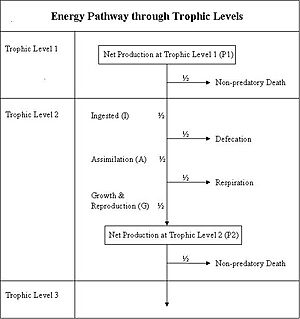Ecological efficiency facts for kids
Ecological efficiency is about how well energy moves from one living thing to another in an ecosystem. It shows how much energy is passed on when one animal eats another, or when an animal eats a plant. This efficiency depends on how organisms get and use their food.
Contents
How Energy Moves in Nature
Energy first enters an ecosystem through autotrophs, which are organisms that make their own food. Think of plants and algae. They are photoautotrophs because they use sunlight to create energy. This process is called photosynthesis, and it happens in the green parts of plants.
Once plants make energy, it moves through the ecosystem. Animals that eat plants (like deer) get some of that energy. Then, animals that eat other animals (like wolves eating deer) get energy from them. This path of energy is called a food chain.
When plants capture energy from the sun, we can talk about two types of production:
- Gross primary production is all the energy a plant takes in from the sun.
- Net primary production is the energy left after the plant uses some for its own life processes, like breathing. This is the energy available for animals that eat the plant.
Energy transfer between different levels of the food chain is not very efficient. A lot of energy is lost at each step. This happens because some energy is used for daily activities, some is lost as heat, and some food isn't fully digested.
For example, if a plant has 500 units of energy, an animal that eats it might only get about 63 units of that energy for its own growth and reproduction. This is because much of the energy is lost through things like not being eaten, waste, and breathing.
Measuring Energy Flow
Scientists try to measure how much energy moves through an ecosystem. They look at different types of efficiency:
- Exploitation efficiency is how much food an animal eats compared to how much food is available.
- Assimilation efficiency is how much of the eaten food an animal actually uses for its body, after digestion.
- Net Production efficiency is how much of the used energy turns into new body mass (growth and reproduction).
- Ecological efficiency combines all these. It's the total amount of energy that moves from one level of the food chain to the next.
It can be hard to measure these things exactly. For example, knowing how much food all animals in an ecosystem eat, and how much energy is in that food, is very difficult. So, these measurements are often good guesses rather than perfect numbers. But even a good guess helps us understand how energy flows in nature.
Energy Efficiency in Our Lives
Understanding ecological efficiency is important, especially in farming. Farmers want to get the most energy from their crops and livestock.
For example, when comparing different types of cattle, beef cattle are better at turning feed into stored energy (like fat) than dairy cattle. This means raising cattle for meat can be a more efficient use of feed than raising them for milk.
It's also important to think about eating plants versus eating animals. While animal products like meat can have a lot of energy, it takes a lot of energy to grow the food that animals eat. Much of that energy is lost as the animal grows.
Think about it this way:
- To produce edible calories, chicken gives back about 18% of the energy put into its feed.
- Beef gives back about 6.7%.
- Farmed salmon gives back about 5.7%.
- Shrimp gives back only about 0.9%.
But plants are much more efficient:
- Potatoes can give back 123% of the energy put into growing them.
- Corn can give back 250%.
- Soy can give back 415%.
This shows that eating foods from lower levels of the food chain (like plants) is much more energy-efficient than eating foods from higher levels (like meat).
The Ten Percent Law
The ten percent law is a simple rule about energy transfer in food chains. It says that when energy moves from one level of the food chain to the next, only about 10% of that energy is stored in the body of the animal that eats it. The other 90% is lost. This loss happens because of daily activities, breathing, and incomplete digestion.
For example:
- Imagine the sun gives 10,000 units of energy.
- Plants only capture a small part of that, maybe 100 units (about 1% of the sun's energy).
- A deer eating the plant would get about 10 units of energy (10% of the plant's energy).
- A wolf eating the deer would get about 1 unit of energy (10% of the deer's energy).
This law helps us understand why there are fewer animals at the top of the food chain. It also shows that getting our food from sources closer to the sun (like plants) is the most energy-efficient way to eat.
See also
- Eco-efficiency - how well human society uses natural resources.


